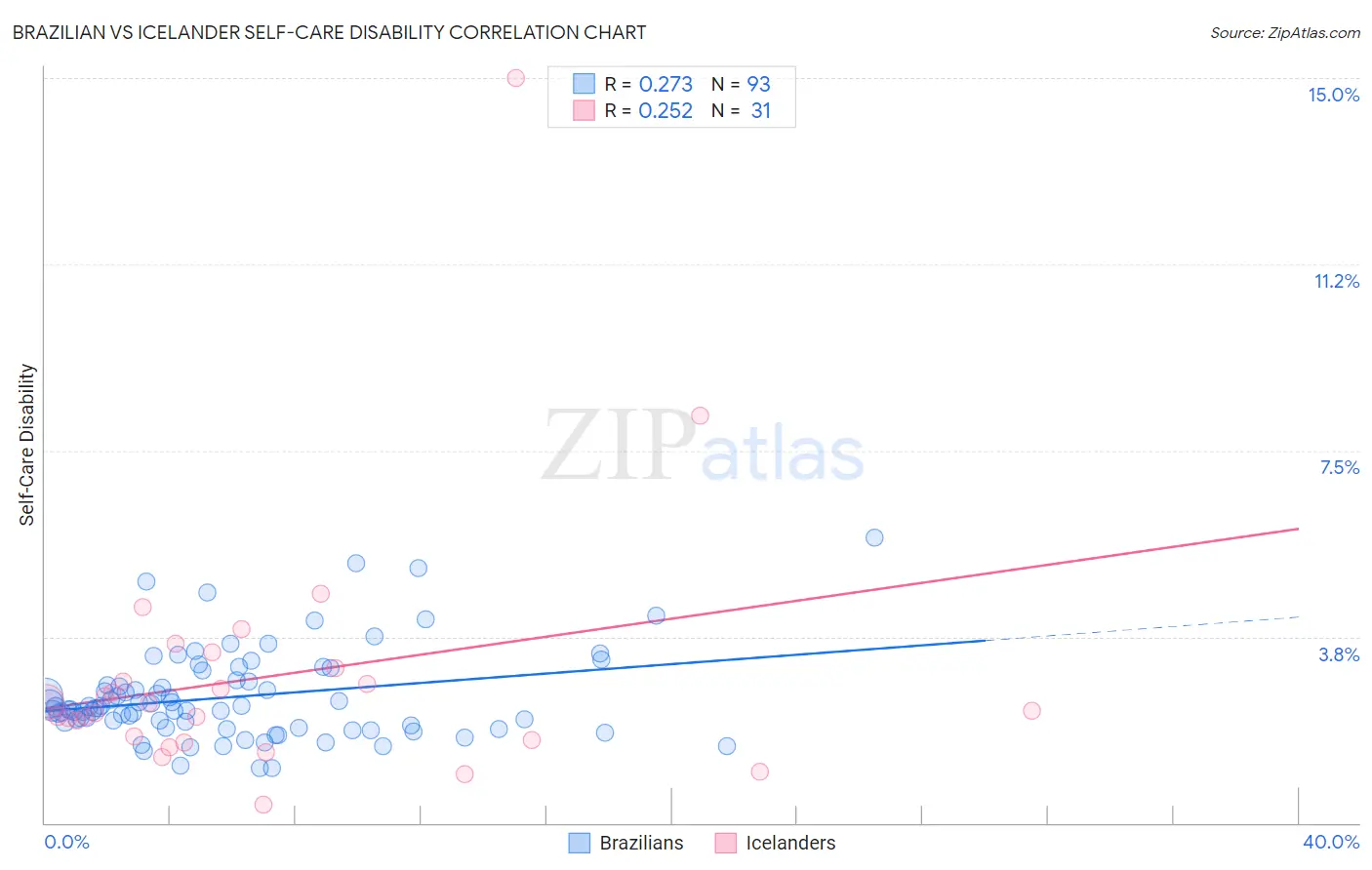Brazilian vs Icelander Self-Care Disability
COMPARE
Brazilian
Icelander
Self-Care Disability
Self-Care Disability Comparison
Brazilians
Icelanders
2.3%
SELF-CARE DISABILITY
99.3/ 100
METRIC RATING
65th/ 347
METRIC RANK
2.4%
SELF-CARE DISABILITY
97.4/ 100
METRIC RATING
92nd/ 347
METRIC RANK
Brazilian vs Icelander Self-Care Disability Correlation Chart
The statistical analysis conducted on geographies consisting of 323,606,660 people shows a weak positive correlation between the proportion of Brazilians and percentage of population with self-care disability in the United States with a correlation coefficient (R) of 0.273 and weighted average of 2.3%. Similarly, the statistical analysis conducted on geographies consisting of 159,567,572 people shows a weak positive correlation between the proportion of Icelanders and percentage of population with self-care disability in the United States with a correlation coefficient (R) of 0.252 and weighted average of 2.4%, a difference of 1.7%.

Self-Care Disability Correlation Summary
| Measurement | Brazilian | Icelander |
| Minimum | 1.1% | 0.38% |
| Maximum | 5.7% | 15.0% |
| Range | 4.6% | 14.6% |
| Mean | 2.5% | 2.9% |
| Median | 2.3% | 2.3% |
| Interquartile 25% (IQ1) | 1.9% | 1.7% |
| Interquartile 75% (IQ3) | 2.9% | 3.1% |
| Interquartile Range (IQR) | 0.91% | 1.4% |
| Standard Deviation (Sample) | 0.90% | 2.6% |
| Standard Deviation (Population) | 0.90% | 2.6% |
Similar Demographics by Self-Care Disability
Demographics Similar to Brazilians by Self-Care Disability
In terms of self-care disability, the demographic groups most similar to Brazilians are Immigrants from Argentina (2.3%, a difference of 0.030%), Swedish (2.3%, a difference of 0.060%), South African (2.3%, a difference of 0.060%), Mongolian (2.3%, a difference of 0.070%), and Immigrants from Zaire (2.3%, a difference of 0.15%).
| Demographics | Rating | Rank | Self-Care Disability |
| Immigrants | Cameroon | 99.6 /100 | #58 | Exceptional 2.3% |
| New Zealanders | 99.5 /100 | #59 | Exceptional 2.3% |
| Immigrants | Japan | 99.5 /100 | #60 | Exceptional 2.3% |
| Palestinians | 99.4 /100 | #61 | Exceptional 2.3% |
| Egyptians | 99.4 /100 | #62 | Exceptional 2.3% |
| Mongolians | 99.3 /100 | #63 | Exceptional 2.3% |
| Swedes | 99.3 /100 | #64 | Exceptional 2.3% |
| Brazilians | 99.3 /100 | #65 | Exceptional 2.3% |
| Immigrants | Argentina | 99.3 /100 | #66 | Exceptional 2.3% |
| South Africans | 99.3 /100 | #67 | Exceptional 2.3% |
| Immigrants | Zaire | 99.2 /100 | #68 | Exceptional 2.3% |
| Immigrants | Norway | 99.2 /100 | #69 | Exceptional 2.3% |
| Immigrants | Northern Europe | 99.2 /100 | #70 | Exceptional 2.3% |
| Asians | 99.2 /100 | #71 | Exceptional 2.3% |
| Eastern Europeans | 99.2 /100 | #72 | Exceptional 2.3% |
Demographics Similar to Icelanders by Self-Care Disability
In terms of self-care disability, the demographic groups most similar to Icelanders are Immigrants from Jordan (2.4%, a difference of 0.14%), Immigrants from Czechoslovakia (2.4%, a difference of 0.15%), Immigrants from Latvia (2.4%, a difference of 0.19%), Macedonian (2.4%, a difference of 0.24%), and Immigrants from Asia (2.4%, a difference of 0.25%).
| Demographics | Rating | Rank | Self-Care Disability |
| Estonians | 98.3 /100 | #85 | Exceptional 2.3% |
| Immigrants | Northern Africa | 98.2 /100 | #86 | Exceptional 2.3% |
| Sierra Leoneans | 98.0 /100 | #87 | Exceptional 2.4% |
| Lithuanians | 98.0 /100 | #88 | Exceptional 2.4% |
| Immigrants | Congo | 98.0 /100 | #89 | Exceptional 2.4% |
| Immigrants | Czechoslovakia | 97.7 /100 | #90 | Exceptional 2.4% |
| Immigrants | Jordan | 97.7 /100 | #91 | Exceptional 2.4% |
| Icelanders | 97.4 /100 | #92 | Exceptional 2.4% |
| Immigrants | Latvia | 97.0 /100 | #93 | Exceptional 2.4% |
| Macedonians | 96.9 /100 | #94 | Exceptional 2.4% |
| Immigrants | Asia | 96.9 /100 | #95 | Exceptional 2.4% |
| Immigrants | Chile | 96.7 /100 | #96 | Exceptional 2.4% |
| Swiss | 96.6 /100 | #97 | Exceptional 2.4% |
| Immigrants | Poland | 96.4 /100 | #98 | Exceptional 2.4% |
| Immigrants | Israel | 96.1 /100 | #99 | Exceptional 2.4% |